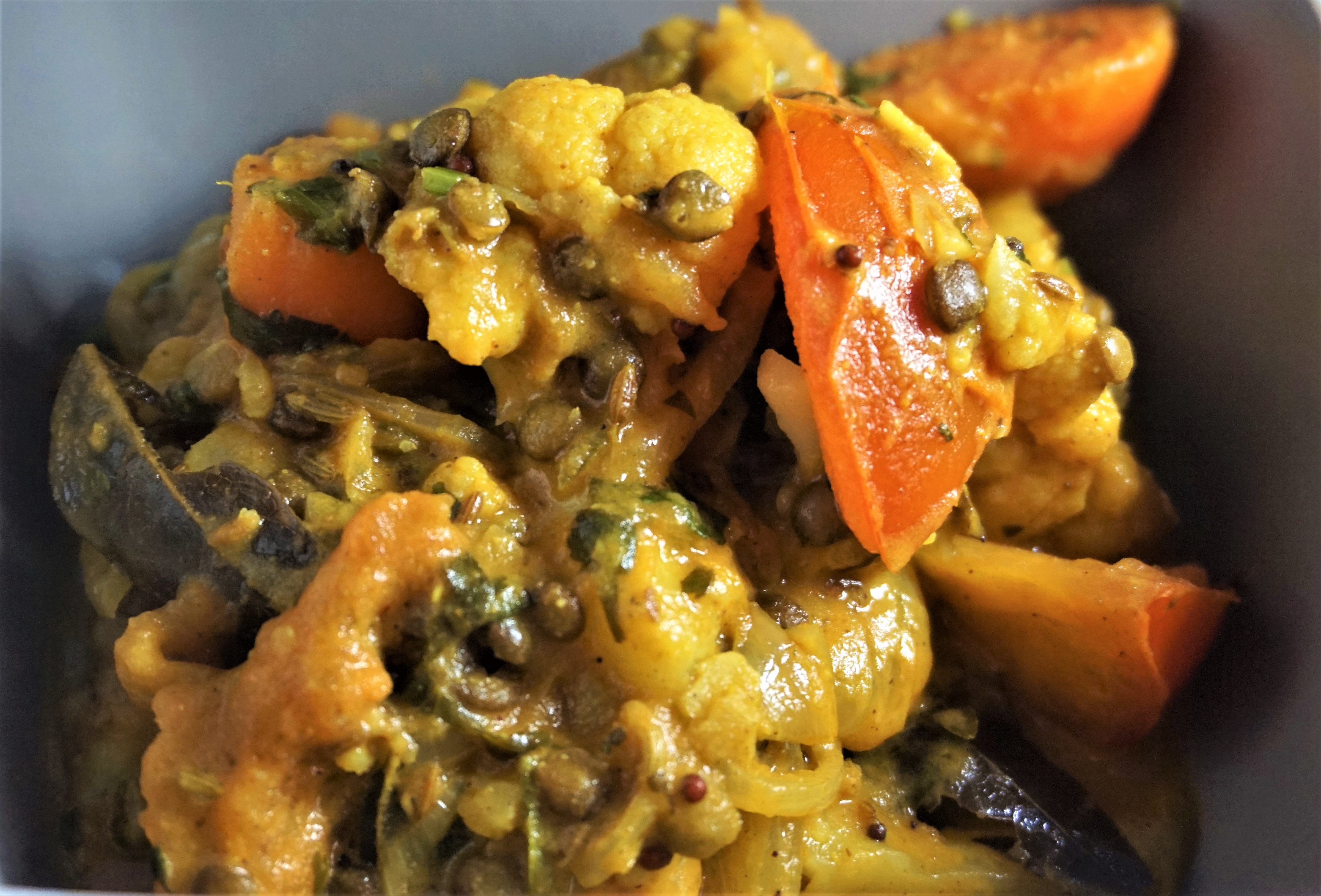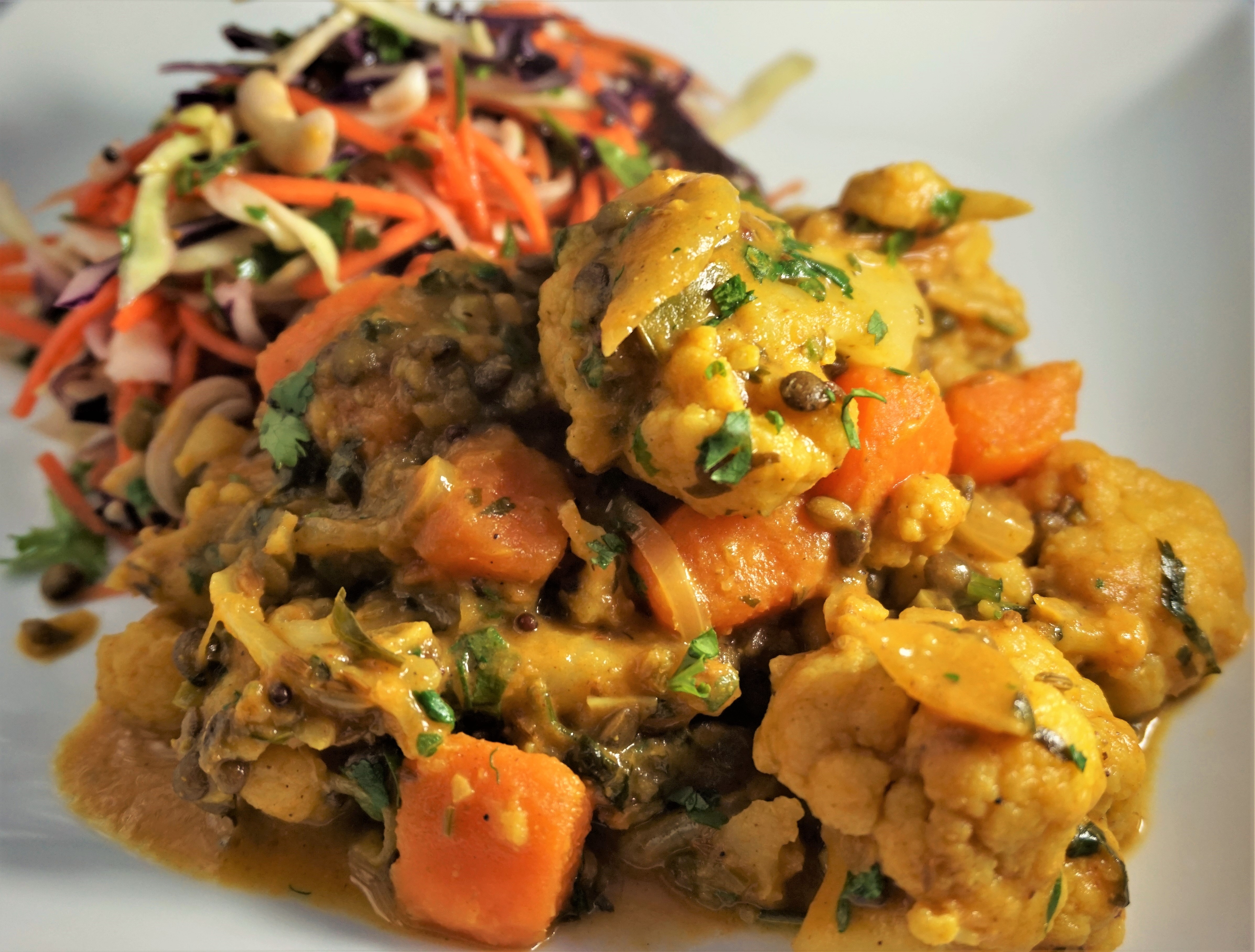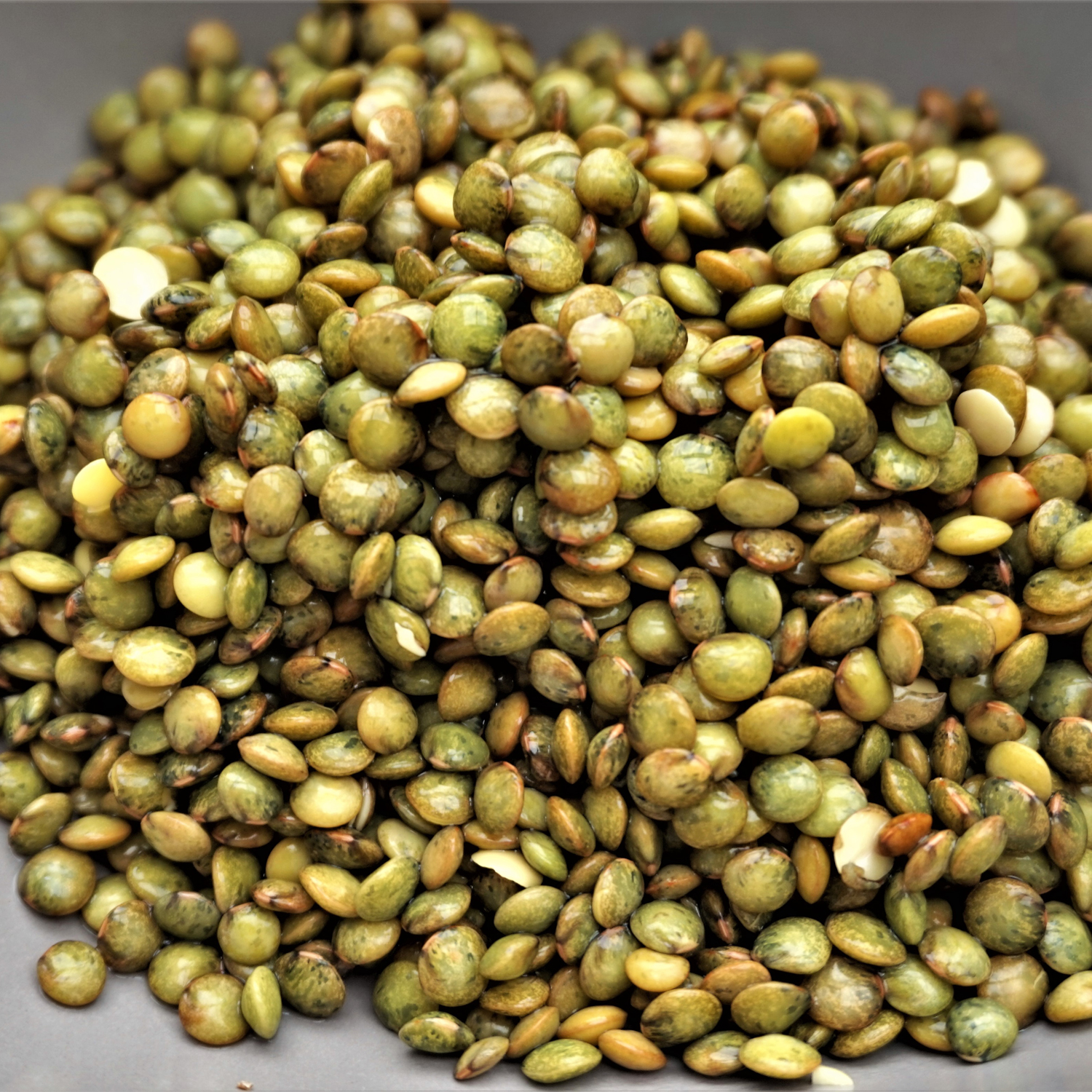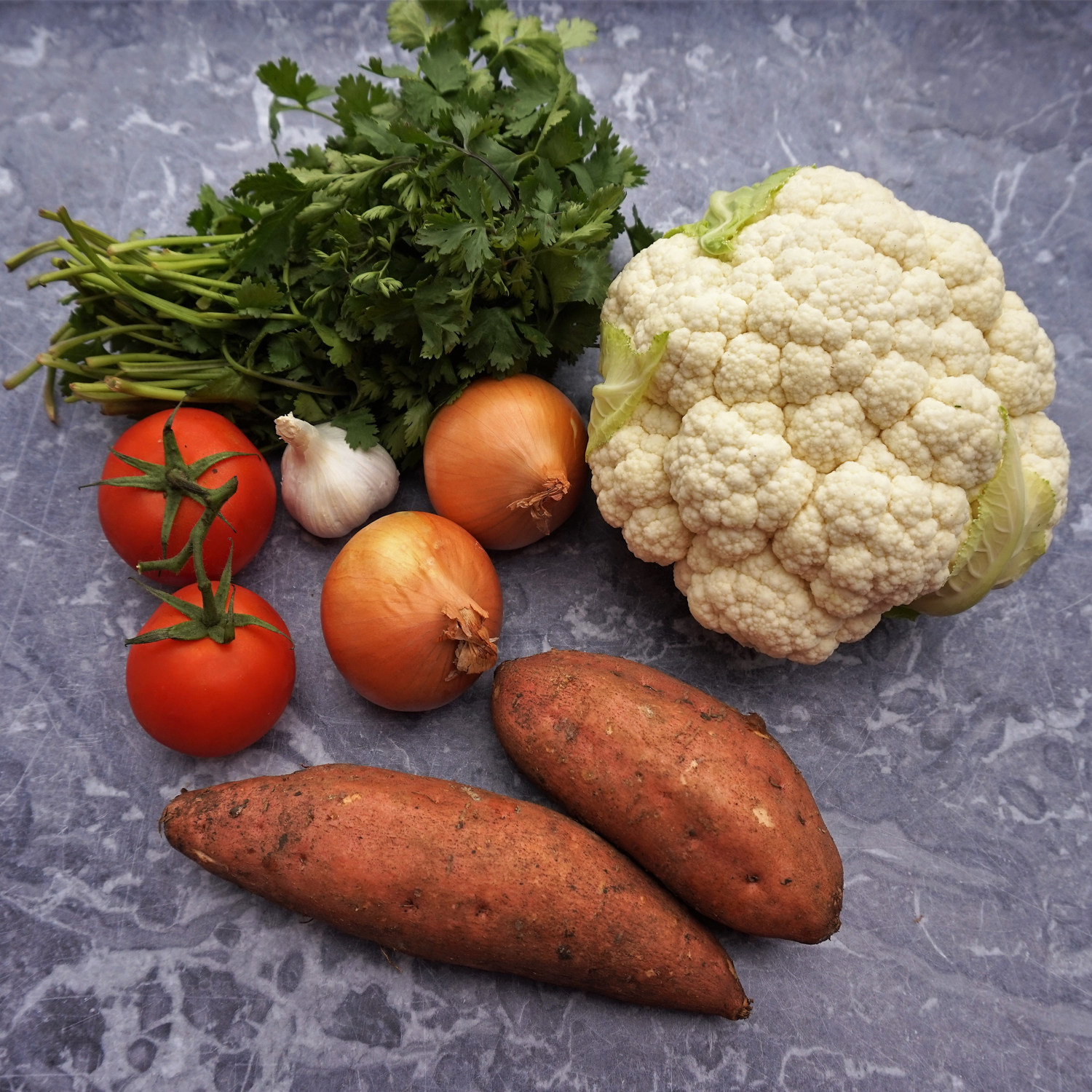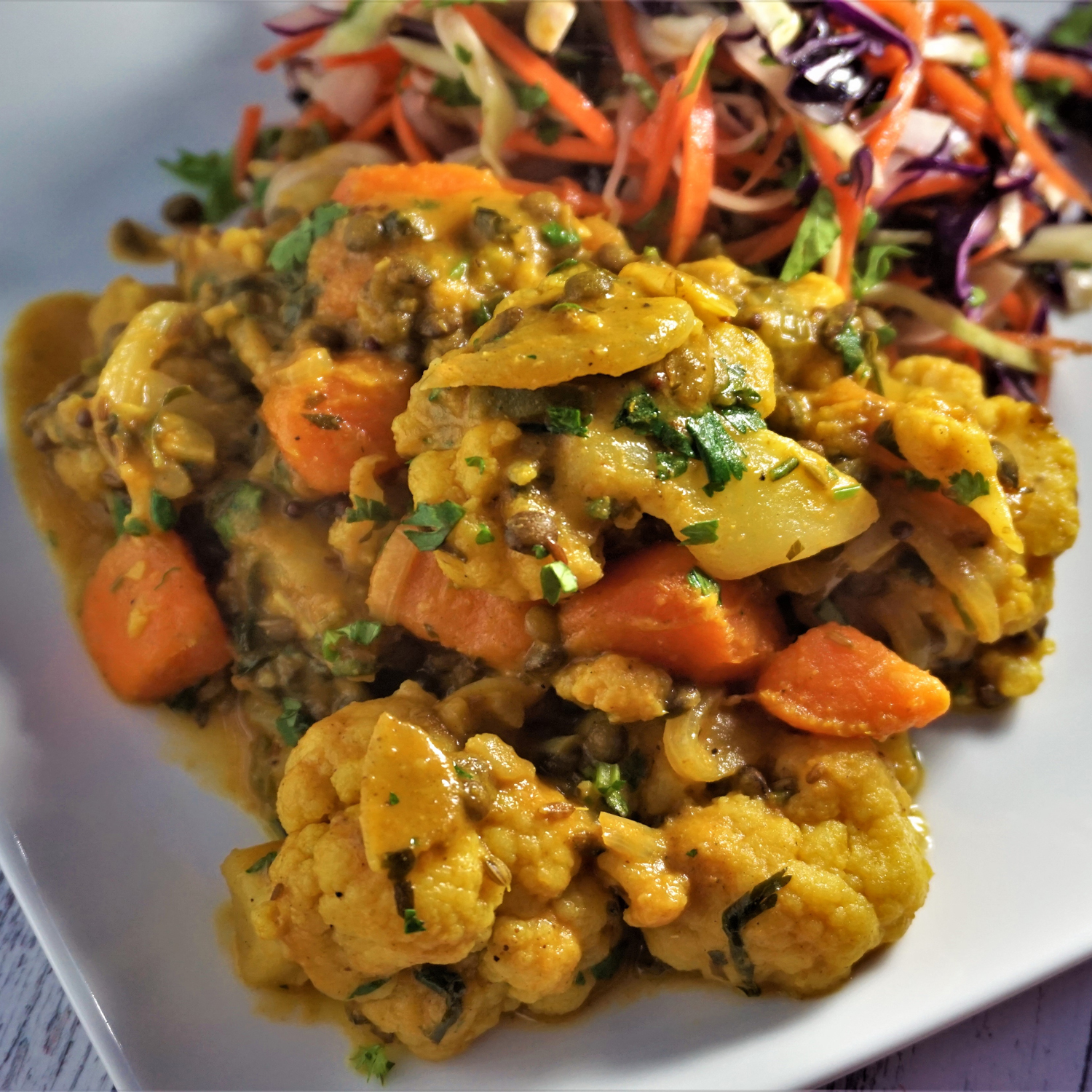Aloo Gobi with Lentils
My Aloo Gobi with Lentils takes a favourite British Indian restaurant side dish of potatoes and cauliflower and turns it into a main course with the addition of earthy green lentils. Once you’ve built up a supply of spices, you’ll find that cooking delicious Indian-inspired dishes like this from scratch is easier than you thought.
INDIAN CUISINE: ONE OF THE WORLD’S GREATS
I love spicy food of all kinds and one of my favourites is Indian.
But, popular though Indian restaurants are in the UK, I wonder if Indian (and Pakistani) food is really understood or taken seriously enough outside of the British Asian communities. I certainly don’t meet that many people with non-Indian or Pakistani heritage who know how to cook food from the Indian subcontinent from scratch, using individual spices rather than a jarred paste or, even worse, a packaged sauce.
This was brought home to me when I read many ignorant and disparaging comments directed at Saliha Mahmood-Ahmed, of Pakistani heritage, when she won BBC’s Masterchef 2017. Lots of online trolls posted that she shouldn’t have won as she could only cook one thing: ‘Asian’ or ‘curry’.
So, the aim of this post is to get more people cooking some of the wonderful cuisine from the Indian subcontinent for themselves. It needn’t be difficult to get started, but will hopefully give a wider appreciation of the fantastic flavours that can be had once you develop a knowledge of spices and how to use them.
MY JOURNEY
I’ve been cooking Indian food for the best part of 30 years. When I first left home I was vegetarian, then vegan and, having little money, I found that so long as I had spices in the cupboard (initially just ground cumin, coriander, turmeric and chilli powder) I could make pretty tasty Indian-style food with the addition of as many fresh vegetables as I could afford plus tinned tomatoes, dried beans, lentils and rice.
Shortly after leaving home, I moved to Leicester with its array of British Asian-owned grocers and restaurants which widened my horizons. I now had access to a more diverse range of spices and ingredients. This was a world away from my almost exclusively white hometown in the 1980 where even finding garlic wasn’t easy.
I still regularly make lots of Indian and Pakistani-influenced food, including meat dishes, and we have a vegan or vegetarian ‘curry’ type meal pretty regularly.
Aloo Gobi: a great dish for beginners
A favourite at the moment, and a good one to start with if you haven’t cooked food like this from scratch before, is Aloo Gobi or potatoes and cauliflower.
It’s a North Indian dish, popular as a vegetable side in British Indian restaurants. And no wonder – both vegetables take up the flavour of spices really well.
At home, I like to eat it as a main course and so, to make it a little more substantial and nutritionally balanced, I add cooked green lentils. I use dried lentils rather than the tinned or vacuum-packed ones. To cut down the cooking time, I soak them in boiled water which cuts the cooking time down to around 12 minutes. For the 180g of cooked lentils used in this recipe, I started off with 75 g of dried green lentils. You could substitute any other cooked lentil or bean, of course.
As a change from the regular, white potatoes traditionally included in this dish, I’ve used sweet potatoes. But if you want to stick with white then go for a waxy or firm one (e.g. Charlotte or Desiree) so they don’t turn to mush during the cooking.
This is a relatively simple dish that doesn’t take very long once you’ve assembled the ingredients. You can adjust the amount of chilli to make it as hot or as mild as you like too. Aloo Gobi includes tomatoes but not enough to make it a wet, saucy curry – it should be just nicely moist.
Spices you’ll need, some you might like & what to serve with Aloo Gobi
Although my spicing of this dish is relatively traditional (cumin and mustard seeds, turmeric, ground coriander and garam masala), I’ve made a few of additions of my own (fennel seeds, ground fenugreek and curry leaves) as these are some of my favourite flavours in Indian food, but you could leave them out.
If you’re not used to cooking Indian food, the list of spices may seem a little daunting. However, once you’ve built up a supply, you’ll have so many options for meals that you can get away with not having to buy a lot of extra ingredients any time you want to make a spicy dish. I’ve included an image below of the contents of my spice cupboard and spice tin – and yes, the cupboard is in alphabetical order…
I also love anything flavoured with coconut so add a little coconut milk at the end. The coconut milk also gives richness, but a good knob of butter would do the same job.
In India Aloo Gobi is traditionally served with bread (I love homemade chapatti) but in our house we tend to have it with minted yogurt and a fresh salad of some kind. Occasionally we’ll have brown rice too.
Recently I’ve been serving Aloo Gobi with a lovely crunchy Asian style coleslaw inspired by Saliha Mahmood-Ahmed, containing red and white cabbage, carrots, peppers, cashew nuts, coriander leaf and coconut flakes. It’s dressed with black mustard seeds, cumin seeds, fennel seeds and chilli flakes heated in oil, mixed with lemon, salt and a little honey. Spices tempered in oil to finish a dish like this is called a tadka or tarka – hence the name of popular dishes such as tarka dal.
My Aloo Gobi with Lentils
For this recipe, I like to parboil the potatoes and cauliflower, separately, in salted water before I get started on the sauce and then set them aside. You don’t want the vegetables underdone which can happen if you put them in the sauce raw as sometimes they seem to take an age to cook. When they’ve been parboiled, they should still have some bite as they’ll finish cooking later.
The sauce is started by sautéing onions in oil in a large pan or wok. I use coconut oil for this dish but any oil, or ghee, or mixture of oil and butter can be used. Once the onions are softening and taking on some colour, fresh garlic, chilli and ginger plus whole spice seeds and curry leaves are added and fried for a few minutes.
The parboiled vegetables and cooked lentils are stirred into the mix so they take on a little colour and flavour and then the ground spices, fresh tomatoes, tomato puree (you can substitute both of these with a tin of chopped tomatoes), fresh coriander and seasonings are added, along with a little water to moisten. A lid is put on and within 15-20 minutes the Aloo Gobi should be done, the vegetables cooked but still holding their shape. While it’s cooking, take a look now and then, give it a stir, check that the mixture isn’t too dry and add more water if needed.
For the last 5 minutes of cooking, I add coconut milk and simmer with the lid off to reduce it. When ready to serve, I stir in some more fresh coriander and a squeeze of lemon.
I hope you’ll try this recipe and, if you’re new to this style of cooking, you’ll discover that it’s really worth having a supply of spices so you can create dishes to your own taste and which will have so much more distinctive flavour than shop-bought pastes and sauces.

Aloo Gobi with Lentils
Spicy potatoes and cauliflower are made into a tasty main course by the addition of lentils.
Ingredients
- 500 g sweet potato peeled, cut into bite sized chunks
- 600 g cauliflower broken into large pieces
- 2 tbsp coconut or other oil
- 2 medium onions halved & sliced
- 4 cloves garlic sliced or chopped
- 1-2 green chillies sliced
- 1 tbsp grated ginger
- 2 tsp cumin seeds
- 2 tsp black mustard seeds
- 2 tsp fennel seed optional
- 1 handful curry leaves optional
- 180 g cooked green lentils
- 0.5 tsp ground turmeric
- 2 tsp ground coriander
- 1 tsp ground fenugreek optional
- 2 tsp garam masala
- 2 medium tomatoes quartered
- 1 tbsp tomato puree
- 1 tsp brown sugar
- 1 tsp salt
- 4 tbsp coriander leaf roughly chopped
- 150 ml coconut milk optional
- 1 lemon juice only
Instructions
-
In salted water, separately parboil the sweet potato and cauliflower pieces until almost cooked (5-10 min). Set aside.
-
Heat the oil in a large frying pan, saute pan or wok then add the onion and cook over a medium heat for 10 min, stirring regularly and making sure it doesn't burn.
-
Add the garlic and continue to cook, stirring regularly, for a further 5 min until the onion and garlic are softening and starting to brown.
-
Add the chilli, ginger, cumin, mustard and fennel seeds and the curry leaves. Stir and cook for 5 min.
-
Add the potatoes, cauliflower, cooked lentils and fry until spots on them are starting to brown a little (5 min).
-
Add the turmeric, ground coriander, fenugreek and garam masala. Stir.
-
Add the tomatoes, tomato puree, sugar, salt, 2 tbsp of the chopped coriander and 200ml of water. Stir, scraping up any spices stuck to the bottom of the pan, bring to the boil and immediate turn down the heat to low.
-
Put a lid on and simmer until the vegetables are cooked through, but still hold their shape (15-20 min).
-
If using, add the coconut milk and simmer with the lid off until it's reduced (5 min).
-
Check the seasoning: stir in a little more salt or garam masala if you think it needs it.
-
Just before serving, stir in the remaining 2 tbsp of chopped coriander and the lemon juice.

